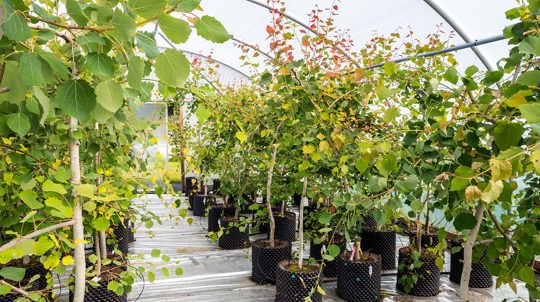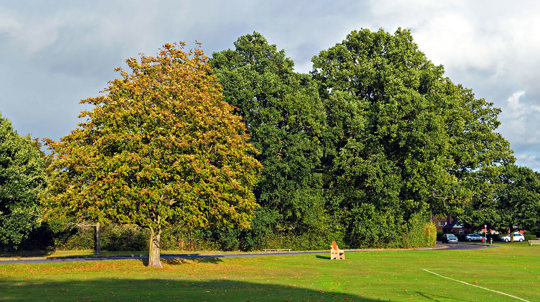Key tree pests and diseases
Increasing numbers of pests and diseases are attacking the UK's trees. Some with devastating consequences. Here are the key tree pests and diseases, with symptoms, outlook and how you can report them.
-
Trees woods and wildlife
Ash dieback
Ash dieback will kill around 80% of ash trees across the UK. At a cost of billions, the effects will be staggering. It will change the landscape forever and threaten many species which rely on ash.
-
Trees woods and wildlife
Acute oak decline
Our native oaks are under pressure like never before. They are declining at an unprecedented rate due to drought, flooding, pollution, pests and diseases.
-
Trees woods and wildlife
Asian and citrus longhorn beetles
The Asian longhorn beetle is a killer of broadleaf trees. It’s not in the UK yet, but there’s a high risk of it being imported on wood packaging.
-
Trees woods and wildlife
Bronze birch borer
A pest which could have a huge impact on our native birches, the bronze birch borer is native to North America and a serious threat to our trees.
-
Trees woods and wildlife
Dothistroma needle blight
This fungal disease can have a serious impact on our native Scots pines. It could spell trouble for our rare, ecologically invaluable Caledonian pine forests.
-
Trees woods and wildlife
Dutch elm disease
This now infamous tree disease has killed millions of elm trees in the UK over the last 50 years. It’s changed parts of our landscape forever and it’s still spreading north.
-
Trees woods and wildlife
Eight-toothed spruce bark beetle
One of the most serious forestry pests in Europe. If left uncontrolled, the eight-toothed spruce bark beetle has the potential to cause significant damage to the UK’s forestry and timber industries.
-
Trees woods and wildlife
Elm zig-zag sawfly
The newest threat to our already damaged elm populations, the larvae of the elm zig-zag sawfly can defoliate whole trees.
-
Trees woods and wildlife
Emerald ash borer
The emerald ash borer has killed billions of ash trees in the US. If it gets here, it will do the same to our already vulnerable ash populations.
-
Trees woods and wildlife
European mountain ash ringspot-associated virus
The European mountain ash ringspot-associated virus attacks the leaves of rowan trees, leaving them weakened.
-
Trees woods and wildlife
Great spruce bark beetle
The great spruce bark beetle damages spruce trees by tunnelling into the bark. This pest was accidentally introduced into the UK in 1982 and now has become established in Western England, Wales and Southern Scotland.
-
Trees woods and wildlife
Horse chestnut bleeding canker
Huge horse chestnut trees are icons in our parks and gardens, but they are under threat from two invaders: a bacterium and a leaf miner.
-
Trees woods and wildlife
Horse chestnut leaf miner
The larvae of the horse chestnut leaf miner bores within horse chestnut leaves, eventually causing them to drop and harming the tree and leaving it vulnerable.
-
Trees woods and wildlife
Plane wilt
A serious fungal disease of plane, plane wilt is usually fatal and can kill trees within two to five years.
-
Trees woods and wildlife
Oak lace bug
An insect pest which attacks oaks, the oak lace bug can reduce growth and weaken trees. With number of other diseases already affecting oaks, the arrival of the oak lace bug would pose a serious threat.
-
Trees woods and wildlife
Oak processionary moth
The oak processionary moth not only strips oak trees of their leaves, leaving them vulnerable, but also poses a health risk to humans causing rashes and breathing difficulties.
-
Trees woods and wildlife
Oriental chestnut gall wasp
This newly introduced pest is the only organism to produce galls on sweet chestnuts. If numbers grow, it could have a serious impact on our historic trees.
-
Trees woods and wildlife
Phytophthora austrocedri
Phytophthora austrocedri is a pathogen that infects and kills native juniper trees. Junipers are one of our rarest native trees and an attack from this fungi-like species is a devastating blow to some of the UK’s populations.
-
Trees woods and wildlife
Phytophthora lateralis
A fatal fungus-like species that attacks Lawson cypress, Phytophthora lateralis stops trees from transporting vital nutrients.
-
Trees woods and wildlife
Phytophthora ramorum
Phytophthora ramorum is a fungal-like organism that causes the death of a wide range of trees and shrubs. The greatest impact so far has been on larch plantations, leading to thousands of hectares of felling around the UK.
-
Trees woods and wildlife
Pine processionary moth
Feeding on the needles of pine trees, the pine processionary moth is seriously destructive. They can rapidly strip trees of their needles in forests in Asia, Africa and southern Europe, leaving them vulnerable. Now, there are fears it’s heading north to the UK.
-
Trees woods and wildlife
Red-necked longhorn beetle
The red-necked longhorn beetle is native to eastern Asia and is a serious threat to trees in the genus Prunus like cherries and plums. Its larvae tunnel and feed under the bark and in the wood causing low fruit yield and possible death.
-
Trees woods and wildlife
Sirococcus tsugae
A fungal disease that attacks cedars and hemlock, Sirococcus tsugae can cause disfigurement and eventually death to shoots and branches.
-
Trees woods and wildlife
Sweet chestnut blight
This fungus infects trees through fissures or wounds, and it has the potential to have a significant impact on our historic sweet chestnut woods.




